| Botanical Name |
|
| Family |
Anacardiaceae - The mango family. |
| Pronunciation |
|
| Common Name(s) |
Afrikaans: Duinekraaibessie
|
| Plant Group |
- Shrub A woody plant of relatively low height, having several stems arising from the base and lacking a single trunk; a bush.
|
| Plant Size |
- Very large
| Tree | Over 25m |
| Shrub | Over 4m |
| Perennial/ground cover | Over 1m |
| Bulb | Over 1.2m |
| Succulent | 1.5m to 2m |
|
| Position |
- Canopy Shade Canopy shade is found below closely grown trees where some light filters through. Ideal for the protection of herbaceous plants.
- Dry Shade Shady areas where soil has poor water retention or are dependent on rain for their moisture needs.
- Light or Dappled Shade Found below trees with sparse, open foliage. Ideal for the protection of herbaceous plants.
- Partial Shade The area is in shade for part of the day and in full sun for part of the day.
- Sun The area is in full sun for all or most of the day, all year round.
|
| General Information |
- Drought Tolerance: High The plant is well adapted to arid conditions; it can survive long periods of drought and high temperatures without extra water.
- Evergreen Plants that have leaves all year round.
- Frost: Tender A plant that will not survive any frost or low winter temperatures.
- Roots Non-invasive Safe to plant near pools, paving, walls or buildings.
- Salt spray tolerant A plant with specific adaptations enabling it to grow in a saline environment.
- Sand tolerant Plants adapted to survive in nutrient poor, very sandy soils.
- Water Wise Plant species originating from low rainfall regions that require less water to survive and thrive than other plant species.
- Wind Tolerant Plants able to withstand the effect of strong winds.
|
| Specific Information |
Searsia crenata is more often a large, much branched, dense shrub than a tree. The attractive foliage consists of small, scalloped leaves which are dark or light green when mature and often reddish and shiny when young. This multi-stemmed, ground-hugging shrub has a softly rounded shape and is an excellent choice for dune stabilisation, background planting and as a pioneer plant for new gardens. The fruits ripen from green to red and finally to dark blue and are eaten by birds.
|
| Ad Break |
|
| Flowers |
| Description |
very small, star-shaped, in clusters at the ends of branches
|
| Season |
- Autumn Plants will seldom bloom for the entire season as given in the list, but should flower during a period within these parameters.
|
| Colour |
|
| Growth Rate |
- Moderate to Fast Specifying growth rate can be very misleading as there is considerable variation of growth rate depending on type and species of plant, available water, supplementary feeding, mulching and general care, as well as the plants suitability and adaptability to the garden environment.
|
| Plant Uses |
- Attracts bees, butterflies or other insects This plant attracts insects which can be food for birds or other creatures in your garden.
- Attracts Birds This plant will attract birds.
- Border A strip of ground, at the edge of a driveway or path in which ornamental plants or shrubs are planted.
- Boundary A plant useful for planting around the edges of the property to form a green or colourful backdrop, an impenetrable hedge, to hide walls or create privacy.
- Filler Either a fast growing tree or shrub used temporarily to fill in an area while the permanent plants grow to a desired size, or a plant used to fill gaps in borders or beds.
- Hedge Suitable trees or shrubs planted relatively close together so that the branches intertwine to create a barrier. This can be formal – the plants are regularly trimmed to produce a neat shape, or informal – the plants are left to themselves to create a natural hedgerow.
- Pioneer for new gardens A very fast growing plant, able to withstand hardship, that can be used to populate land that has recently been cleared of natural vegetation. These plants pave the way for slower-growing species by adding nutrients to the soil and creating leaf litter.
- Screen A tall hedge of suitable plants planted closely together and used as a windbreak, to block a bad view, to separate parts of the garden or as a backdrop.
- Stabilize Banks Plant is used to prevent soil erosion because their roots will form a mat that stabilizes the soil and keeps it from washing away in heavy rains.
- Suitable for bonsai A shrub or tree that lends itself to being dwarfed.
- Suitable for coastal gardens Plants adapted to dry, sandy soil, forceful wind, limited rainfall and intense sunlight.
- Suitable for seaside gardens Plants that will survive the hostile environment of harsh salty winds, dry sandy soil, irregular rainfall and heat found in seaside gardens.
- Wild Garden An indigenous garden planted for the benefit of wildlife and birds. Provides food, water, a variety of mini-biomes and no poisonous chemicals are used.
- Windbreak Trees planted in a row to form protection from prevailing winds by breaking the force of the wind, thereby reducing wind damage.
|
| Distribution and Habitat |
from Cape Town in the Western Cape, through the Eastern Cape to Port Shepstone in KwaZulu-Natal, on coastal dunes
|
| Planting Suggestions |
Searsia crenata prefers sandy, well-drained soil. Add some compost and fertiliser to the soil mix and water until established.
|
| Medicinal Uses |
|
| Ad Break |
|


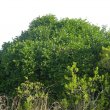
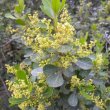
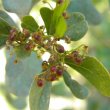
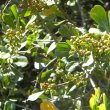
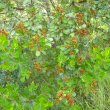
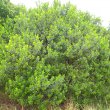


Comments
Trees or shrubs for birds
Hi
I already have a Searsia, Halleria, Chrysanthamoides, Wild Pomegranate, Kigalleria, Strellitzia, Exotic Bottle-brush,
What other trees do you recommend for the birds?
For a sandy, windy Cape Town garden.
Or very large shrubs that I can prune into tree shape.
Also, the wild pomegranate isn't growing :(
Is it too dry and windy here. I put it on the side of the house that is sheltered but it doesn't get a lot of water.
Thanks for a very informative site.
I come here to look up plants mentioned in other articles.
Plants to encourage birds and butterflies
Hi Liza
I have emailed a list of plants used to attract birds and butterflies.
With regards to the Wild Pomegranate, much depends on its earlier pot life. I have found this plant very touchy about being transplanted and they are not happy in pots for too long a time. They get to about knee height and simply stop growing. Once kept too long in a pot my experience was that they simply did not thrive once transplanted into the ground - often because they were pot bound. I think that this is one of the times that smaller is better when buying a plant.
It may also be that the plant is too dry. Although they weather drought very well, they do need some water in the initial stages. Try putting a layer of good compost or a sprinkling of slow release, organic fertiliser, then a thick layer of mulch, in a radius of about 75 cm around the plant. Water well once a week if possible and when necessary. If you don't see results after a few months, it may be that the plant is permanently stunted and will have to be replaced.
Hope this helps.
Kind regards
Lorraine
Discuss this plant
Share knowledge, ask a question or give an experience.